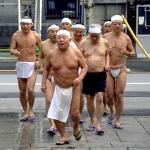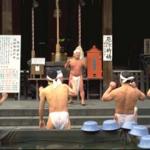Hadaka Matsuri Getting Naked...In Japan...In January
For most of us, a chilly January morning conjures up images of snuggling under blankets in flannel pajamas, sipping hot chocolate by a cozy fire, or schussing down the slopes in snug Gore-Tex jumpsuits and puffy goose-down parkas. But for a large number of questionably sane individuals in Japan, it seems that getting naked in public with a few hundred of their closest friends is the only way to spend the day.
In Japan, the month of January is a time of ritual purification, and for proving one's manhood by enduring frigid temperatures to compete for a coveted prize. During the winter season, clad in nothing more than narrow strips of cloth (variously called shitaobi, mawashi or fundoshi) bound around their loins, countless thousands of men and boys take to the streets and shrines of Japan's many provinces to celebrate the New Year in this uniquely Japanese way. They're called Hadaka Matsuri, and the entire month of January features dozens of these naked festivals.
One of the earliest of the year is the Hadaka Mairi, held at the Komatsu Jinja on the first of January in the town of Bungo Takada in Oita Prefecture on the island of Kyushu. Over 150 years ago, upon completion of the Komatsu shrine, the men of the Heike clan came dressed in loincloths on New Year's Day to offer humble prayers for success in war by purifying themselves in cold water. The ritual has since become an annual event.
Meanwhile, down at the harbor in the same town, early in the morning on January first, a ceremony called Horan-enya is held to pray for a safe, prosperous New Year and a bountiful catch for the fishermen of the town. Those in attendance make ceremonial offerings from colorfully festooned boats, as men in loincloths on both sides of the bay jump into the chilly water and swim to the opposite shore.
A couple of days later, on the morning of January 3, residents of the nearby city of Fukuoka hold an annual festival called Tama Seseri. In this contest, two symbolic wooden figures, male and female, are purified at Hakozaki Shrine. At noon, the figures are transported to Tamatori Ebisu Shrine, where dozens of young men in loincloths await. A Shinto priest tosses the male figure into the crowd of boys, who then scramble and tussle with each other to retrieve it, while spectators douse them with cold water. The boy who successfully seizes and claims the figure is declared the winner. However, he must return it to the shrine for use in next year's competition.
On January 6, out on the west coast of Japan, where the Noto Peninsula joins the mainland of Honshu, the city of Fukuno holds its annual Fire Fighting festival, in which men in loin cloths hold long, decorated bamboo poles into the jets of water from the fire hoses.
The following evening marks one of the liveliest and most famous winter festivals of all. On January 7, in the wintry northern province of Fukushima, the men of Yanaizu gather at Enazo-ji Shrine for the thousand-year-old tradition of Hadaka Mairi, the naked temple visit. Nearly 200 men, dressed only in loincloths, parade through the streets of Yanaizu, up the 113 steep stone steps toward Enazo-ji, some with wishes and resolutions inscribed on their arms and torsos.
At the gates of the temple, they stop at a sacred trough called a suiden to purify themselves with the icy water. When the temple bell rings, they charge the main building, where they vie to be the first contestant to climb a sturdy five-meter rope called the uchizuna suspended from the ceiling. Onlookers cheer as the men struggle to reach the gong that awaits at the top; and once there, they hoist themselves into the rafters of the temple to shout words of encouragement at the climbers below. The strongest competitors are believed to receive special blessings from the gods and to enjoy prosperity, health and good fortune throughout the coming year.
And sometime during the week of January 10, in the heart of downtown Tokyo, men of all ages come to the Teppozu Inari Shrine to participate in the mid-winter bathing ceremony known as Kanchu Suiyoku. As a purification ritual, these intrepid souls, submerged in a pool of near- freezing water, prostrate themselves against huge blocks of ice as they pray to the gods for good health and for the safety of their families in the coming year.
Perhaps the most famous and widely attended of these Hadaka Matsuri is the one held in the city of Inazawa in Aichi Prefecture on the south-central coast of Honshu near the metropolis of Nagoya. On the thirteenth of January, nearly 300,000 people converge upon Konomiya Shrine to witness the spectacle of 10,000 men in loin cloths and wooden sandals, each one hell-bent on touching the Shin-otoko, a naked man chosen by the townspeople to act as a scapegoat to divest them of all evil.
Considered a great honor, the Shin-otoko is but one of more than a thousand chosen ones who have walked, or rather fled pell-mell, naked, through the streets of Inazawa every year for more than 12 centuries. In preparation for the event, the Shin-otoko must undergo many sanctifying rites and shave all the hair from his body. Participants in this event, all of whom must be locals or invited guests, believe that touching the Shin-otoko will bring them good luck in the year to come.
Along the parade route, clusters of men in loincloths anxiously await in the brisk winter air for their turn to lay hands on the Shin-otoko. While they wait, they drink hot sake and write prayers on strips of cloth, which they tie to bamboo fronds for offerings at the temple later in the day. Fortunately, the Shin-otoko has a phalanx of bodyguards to accompany him as he makes his way through the streets of Inazawa. The guards use pails of cold water to ward off overly-eager touchers, but nevertheless, by the time the Shin-otoko reaches the temple gates, the poor guy is pummeled with bruises and reeling from exhaustion.
The Inazawa Hadaka Matsuri culminates in the arrival of the Shin-otoko at Konomiya Shrine, where he spends the final hour of his torment being jostled about by the crowd. At long last, he is allowed to get dressed and relinquish his duties for the day.
Down in the city of Kyoto, a Hadaka Matsuri festival is held on January 14 at Hino Hokai-ji. During these raucous festivities, a throng of loin-clothed young men chant and heave their way through the streets to the shrine. Once they arrive, they splash themselves with water and divide into two groups, raising their hands with palms together and shouting, "Chorai! chorai!" as they clash against each other. The intent of the Hino Hokai-ji Hadaka Matusri is to pray for a bountiful harvest and for the health of the community.
Also on January 14, the sub-arctic city of Sendai holds its Dontosai festival at the Osaki Hachiman Shrine. With a piece of white paper clenched between their teeth, men both young and old make a silent, near-naked pilgrimage through the streets of Sendai to be blessed for good luck in the New Year by the presiding priest at the Shinto shrine. Many participants parade in groups representing their companies or universities, with the leader of each group clacking out a marching rhythm on a pair of wooden hyoshigi, as they walk along in sub-zero temperatures from their offices or schools to the shrine, a distance that may measure several kilometers.
A flaming bonfire kindled from the spectators' cast-off New Year's decorations awaits the shivering marchers at the shrine. After circling the around the fire, the pilgrims proceed to the inner sanctum to receive their blessings. The ceremony concludes with a rousing victory shout, followed by the consumption of copious quantities of hot sake to chase away the winter chill.
On the same day, down in the city of Osaka, Shitennoji Temple hosts a Hadaka Matsuri called DoyaDoya. During the festivities, two groups of young men compete for a sacred amulet of the cow god Gyu-o-Hoin attached to the temple's central pillar. After the struggle, they shout out, "Doya! Doya!" The participants originally believed that this talisman would bring a bountiful harvest to local farmers.
The following day, on January 15, the town of Mihama in Fukui Prefecture is the site of yet another Hadaka Matsuri celebration. On the shores of Lake Hiruga, which adjoins the Sea of Japan through a narrow strait, a large group of young men in loincloths divide themselves into two teams on either side, and engage in a tug-of-war with a straw rope while standing waist deep in the freezing water.
Another January 15 Hadaka Matsuri festival is the 800-year-old celebration in the town of Nagasu in the Kumamoto Prefecture of Kyushu. Here, young men wearing loincloths surge toward a mato target representing the city, the surrounding countryside and the Ariake Sea. Afterwards, the mato is divided among the participants, who carry a tiny shred of it throughout the year as a good luck charm.
Also on the fifteenth on the island of Kyushu is the Aoshima Hadaka Mairi Festival in Miyazaki City. This New Year's event takes place at Aoshima Shrine, facing a formation of wave-eroded rocks known as the Ogre's Washboard. A great taiko drum performance is staged in the center of town, during which a wild procession of loin-clothed men and boys make their way down to the beach to bathe in the frigid waters and pray for good health and safety in the coming year. Afterwards, they head back to town to enjoy taiko drumming while they make a pummeled rice dumpling called omochi.
On the near arctic island of Hokkaido in the village of Kikonai on January 17, four young bachelors in loincloths make a mid-winter pilgrimage called Kanchu Misogi from Samegawa Shrine to the icy, sub-zero waters of the Tsugaru Kaikyo straits that separate the island of Hokkaido from the northern tip of Honshu. Each young man carries a sacred icon, and upon their arrival at the shores of the straits, they wade into the ocean to cleanse the statues. Afterwards, they return to the shrine for another purification ritual.
The Hadaka Matsuri mentioned here are by no means the only ones celebrated in Japan. Numerous others are held throughout the country on many occations thereafter, right on through the breezy cherry blossom season and into the temperate summer months.
There's no denying that these lively festivals make for unforgettable entertainment, and they undoubtedly separate the men from the boys. And who knows? Perhaps all that devout prayer for good health pays off somehow, for the Japanese people truly are among the world's most healthy, hardy and long-lived. Nevertheless, the tradition of Hadaka Matsuri flies in the face of all common sense and it's an absolute wonder they don't all end up with pneumonia!
* * * * *
 ThingsAsian
ThingsAsian


















